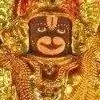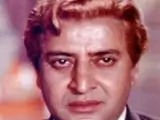GODDESS BHRAMARI, THE NECTARINE GODDESS: The queen bee is to her hive as a Goddess is to her earthlings. Bees serve as images of the miraculous interconnectedness of life. Bees secrete the golden essence of life while living in an intricate cellular structure. The busy bee, following the impulsion of nature, while pollinating flowers gather their nectar to be transformed into madhu - honey. This is similar to continued activity by human who gather crops and transform them into food. The queen bee, who all others serve during their brief life is symbolic of prakrithi and Goddess. Throughout the ages bees and honey have inspired vedic writers and poets; hence the term sacred bees. Bhramari Devi is the Goddess of Black Bees. In Srimad Devi Bagavatam: Book 10, Chapter 13, Maharishi Veda Vyasa speaking in the voice of the sage Narada questions Lord Vishnu: "O Wise One! Who is that Bhramari Devi? What is Her Nature? Narayana states the mythology as thus. ArunadAnava, an asura wanted to establish a kingdom by driving out the devas. Aruna tries to compromise the chastity of the god's wives. He invaded the heavens and dislodged the devas from their abodes. Aruna and his army effortlessly moved into the cities. The devas rushed to Lord Siva who summoned his fellow demons and their wives. The wives were brought before Lord Shiva. Out of fear they prayed to Goddess Parameshwari Devi for help. Pameshwari Devi transformed herself into a large bee from which a swarm of bees emanated. These bees surrounded the wives and sent out further lines of black bees which joined those emerging from her hands to cover the whole earth. The sky was overcast with this swarm and the world was cast into darkness. Nature was filled with bees and was a spectacle of a terrific sight. The demons were torn apart by the bees and the asuras were rendered helpless and incommunicado. They could not use their weapons. Adi Shakti appeared as the divine bee and said "O, asura! Meet your end!" And she stung him to death. Even, Brahma, Vishnu and Maheswara wondered "Whose Maya is this! What a wonder that She will do like this?" The devis thanked Parmeshwari Devi for saving their chastity and sang victory to the Devi'. The various musical instruments, mridangas, murajas and sankhas, bells all sounded in the three worlds and sung Her glory. Devi became glad and gave them separate boon when they went to her lotus feet. That is how Devi got the name of 'Bhramari Devi' as the protector. Brahmari is worshipped on the eighth night of the Navarathri festival. The Bhramari Devi Temple or Kote-ke-mai Temple is attributed toi the Goddess of Bees. There the main deity, Goddess Bhramari is facing north and devotees offer prayer from the south direction of the temple. It is said that Adi Guru Shankaracharya spent valuable time in the Kot Brahmari temple situated at the top of a mount enclosed by a fort in Kasauni. DURGA: Bhramari is also said to be an epithet of Goddes Durga who saves the devas from ArunadAnava. As Bhramaralaka, the bee curl on Her forehead connotes bright charming splendor of her forehead gives solace to her devotees. KUNDALINI YOGA: Bhramari Devi is connected to the teachings of chakras. These seven realms of consciousness emanate from the first sound -- the pulse of the cosmic drum -- the heartbeat of the goddess. The Maha Devi or Great Goddess, Kundalini, manifests in sound form as a queen bee -Bhramari Devi surrounded by a cloud of buzzing bees. This lightening like goddess awakens in a buzz of ascending consciousness and descending spiritual grace. As this buzzing energy rises up the spine it illuminates the chakras which are interconnected with areas of the brain that are silent in the unawakened state. The chakras function as switches that explode the brain into awareness as these dormant areas are activated. KARNA'S CURSE: Karna's yogic training was coming to a completion. One day Karna offered his lap for his guru Parashurama Muni to lay his lap, when he wanted to take a nap. They were under the shadow of a tree. While Parashurama was asleep, Lord Indra came in the disguise of a bee and drilled through Karna's lap. Karna did not want to disturb his guru, so he tolerated the pain. Suddenly Parashurama was woken up by the blood oozing out from Karna's lap and demanded to know who Karna really was. Only a kshatriya could endure such pain. Parashurama who had sworn vengence against kshatriyas cursed Karna that at the moment of greatest need, Karna would forget the mantra to wield the divine weapon Brahmastra. Later he regrets cursing his star pupil. The curse could not be withdrawn. Instead the Muni gave Karna the gift of Bhargavastra, a celestial weapon and a bow called Vijaya. MADHU VIDYA IN THE UPANISHADS: The Upanishads, besides delineating various spiritual experiences, also give a few hints on sadhana, i.e., paths of spiritual realization. These methods of sadhana are called vidyas. This post outlines this in brief. Madhu means honey. Madhu Vidhya aims to realize the Universe as a creation of Bliss. Madhuvidhya or Nectarine Wisdom' is a priceless gift from our ancient rishis. They saw the radiating light rays as nectarine nerves. Om. This Sun is verily the nectar of Gods' - Chandogya Upanishad 3.1.1. " Let every wind that blows drop honey Let the rivers and streams recreate honey Let all our medicines turn honey Let the dawn and evening be full of honey Let the dark particles be converted to honey Our nourisher, this sky above, be full of honey Let our trees be honey Let the Sun be honey Let our cows secrete honey" Rig Veda 1:90:6-8 Nectarine Doctrine' is best dealt under a separate heading together with Savita worship in the days ahead. 
|































